-
League Of Reason Forums will shut down 10th September 2025.
There is a thread regarding this in General Discussion.
You are using an out of date browser. It may not display this or other websites correctly.
You should upgrade or use an alternative browser.
You should upgrade or use an alternative browser.
Biochemist Nick Lane on the origin of life
- Thread starter Rumraket
- Start date
Fascinating.
I have a question and a point.
First the question: This would require life to have originated in these "lost city" vents, correct? It would be fairly unlikely for life to have originated elsewhere (without free protons), then moved to the vents (with free protons) and then evolved from there.
The point: The title is slightly misleading. This requires life to already exist and then evolve. What it does seem to show is where life could likely have arisen. The question I would now be asking is: What were the conditions like in these vents? How could LUCA, or a predecessor of LUCA, have arisen there? etc.
The questions were probably answered in the next talk or their paper, but sadly, time...
I have a question and a point.
First the question: This would require life to have originated in these "lost city" vents, correct? It would be fairly unlikely for life to have originated elsewhere (without free protons), then moved to the vents (with free protons) and then evolved from there.
The point: The title is slightly misleading. This requires life to already exist and then evolve. What it does seem to show is where life could likely have arisen. The question I would now be asking is: What were the conditions like in these vents? How could LUCA, or a predecessor of LUCA, have arisen there? etc.
The questions were probably answered in the next talk or their paper, but sadly, time...
Rumraket
Active Member
This is a kind of metabolism first hypothesis. So there's a significant period of chemical evolution before actual genes and replication arises. I won't bother explaining the underlying reasoning for why these things are postulated, though you or anyone are of course welcome to ask and I will expand upon it. But a super short version of the stages would be:Inferno said:Fascinating.
I have a question and a point.
First the question: This would require life to have originated in these "lost city" vents, correct? It would be fairly unlikely for life to have originated elsewhere (without free protons), then moved to the vents (with free protons) and then evolved from there.
The point: The title is slightly misleading. This requires life to already exist and then evolve. What it does seem to show is where life could likely have arisen. The question I would now be asking is: What were the conditions like in these vents? How could LUCA, or a predecessor of LUCA, have arisen there? etc.
The questions were probably answered in the next talk or their paper, but sadly, time...
The first stage in the origin of life under this scenario is the emergence and sustenance of a simple metabolic cycle ala the reverse Kreb's cycle, catalysed by inorganic mineral and metal clusters (instead of large and complicated RNA and protein enzymes) in the semipermeable membrane structures of which the vent itself is made.
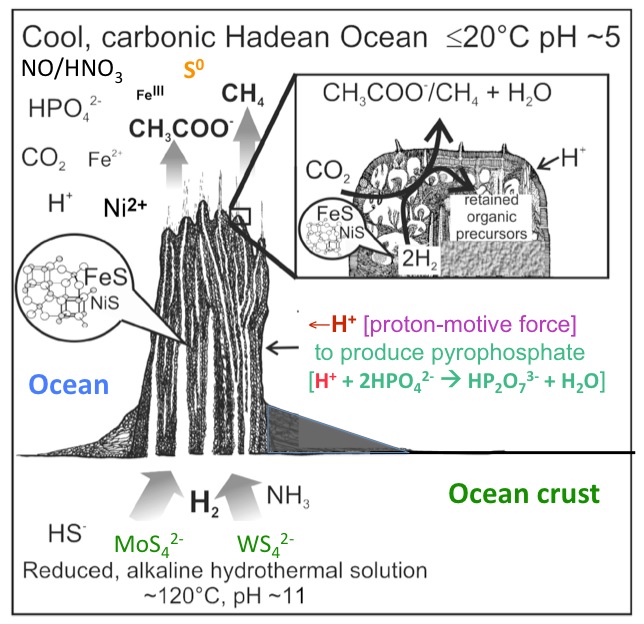
The energy to drive this metabolism comes from chemiosmotic coupling to a natural proton gradient between the reduced, alkaline interior of the vent, and the acidic, carbonic hadean ocean. This energy results in the creation of pyrophosphate.
The reverse Krebs cycle will be the origin of carbon fixation, it is from this that all organic carbon will subsequently emerge. The reverse Krebs cycle is the reaction of CO[sub]2[/sub] with H[sub]2[/sub] to create carbon compounds, today powered by ATP.
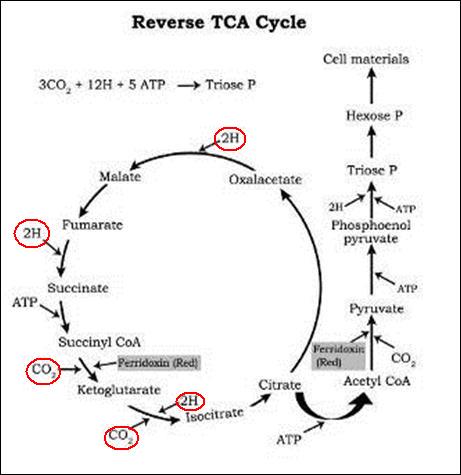
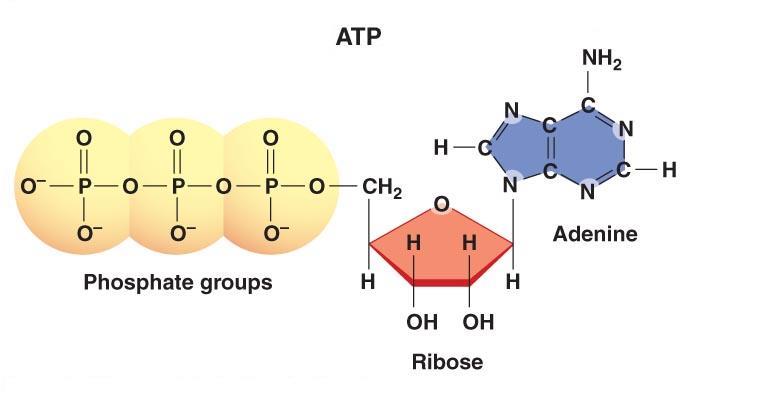
But there were of course no ATP at the origin of life because there's a big fat Adenosine nucleotide sitting there. But that's not a problem, because what we need is the energy from the phosphate bonds. So it's the pyrophosphate that drives our primordial reverse Krebs cycle instead. So everywhere it says ATP here, imagine pyrophosphate instead. (Some cells today can even still use pyrophosphate iirc)
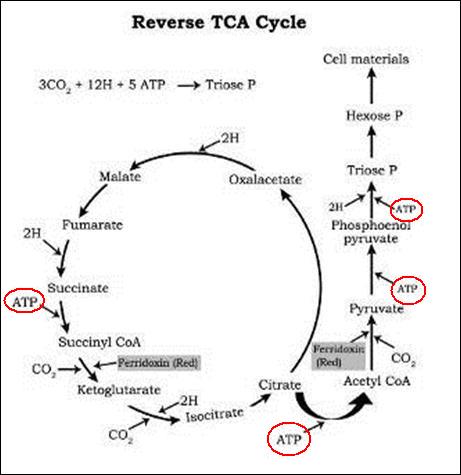
Okay, so we have a reverse krebs cycle running producing small organic molecules.
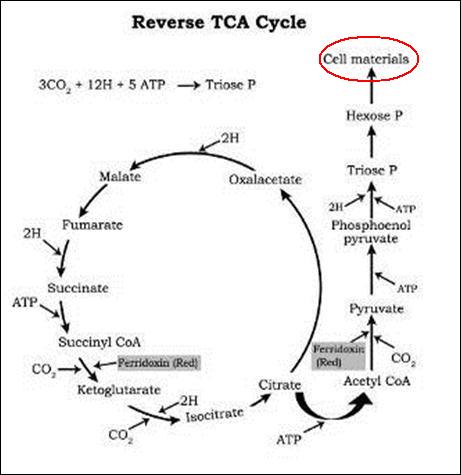
Among them simple sugars such as ribose, and some amino acids. The amino acids can in turn can assemple into small peptides about 6-8 residues in length under the conditions of the vent. Other amino acids are used to build bases (purines and pyrimidines). These are even today, actually synthesized from simple amino acids in extant life.
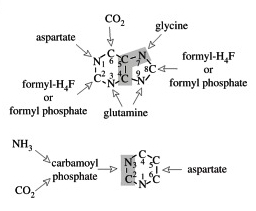
Anyway, some of the peptides interact with the inorganic metal and mineral clusters (the catalysts) and produce a sort of small "proto-enzymes".
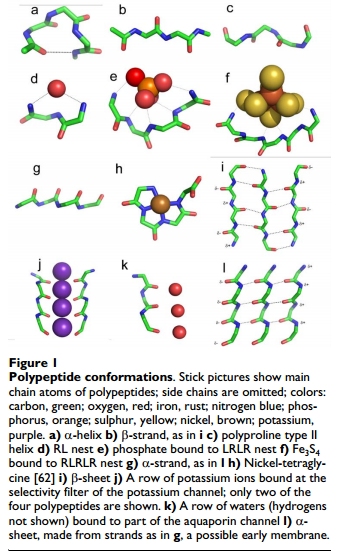
These further enhance the catalytic scope and proficiency of the "proto-enzymes" with their metal cofactors, so they can link together the bases with the ribose and start producing actual nucleotides.
At bottom all this is still fueled by the reverse krebs cycle, which in turn is driven by pyrophosphate, which in turn is still produced by a natural proton motive force.
Soon you get to a coevolving RNA and small-peptide world, in which the genetic code and the translation system subsequently evolves. Among the first "inventions" in this RNA world is the respiratory electron transport chain, the ATP synthase complex and a proton-sodium antiporter complex.
The "grand scheme":
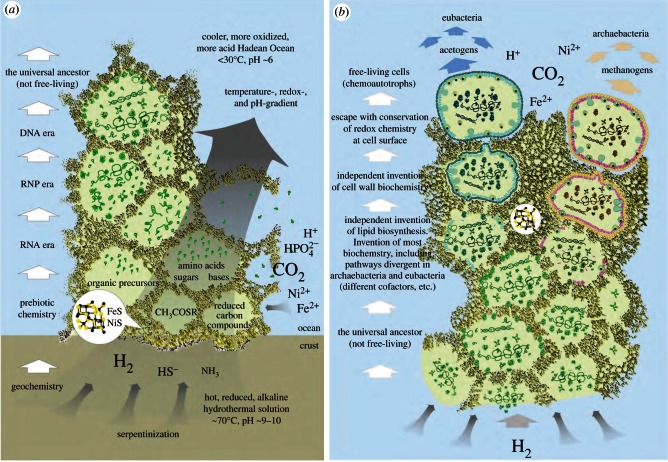
There is some quite solid knowledge of chemistry and physics in support of each of all these postulates. Several steps are being experimentally tested, others have already been.
Good sites for publications on this are -
Michael Russell of NASA:
http://science.jpl.nasa.gov/people/Russell/
Nick Lane of UCL:
http://www.nick-lane.net/Nick Lane Publications.htm
University of Glasgow has an entire site dedicated to this hypothesis:
http://www.gla.ac.uk/projects/originoflife/html/2001/pdf_articles.htm
A good, recent paper I recommend is: http://www.nick-lane.net/Sousa et al Phil Trans.pdf
Inferno said:Fascinating.
I have a question and a point.
First the question: This would require life to have originated in these "lost city" vents, correct? It would be fairly unlikely for life to have originated elsewhere (without free protons), then moved to the vents (with free protons) and then evolved from there.
The point: The title is slightly misleading. This requires life to already exist and then evolve. What it does seem to show is where life could likely have arisen. The question I would now be asking is: What were the conditions like in these vents? How could LUCA, or a predecessor of LUCA, have arisen there? etc.
The questions were probably answered in the next talk or their paper, but sadly, time...
I'm not sure what you mean by "this requires life to already exist and then evolve". I'm guessing that this guy is talking about a metabolism-first hypothesis. So it isn't that life took advantage of those proton gradients, but that those proton gradients led to the appearance of life. Presumably (from the very little he says), via the formation of complex molecules including RNA and proteins (well, he mentions "ribose" at least) (ETA: or, you know, what Rumraket said. Awesome post, Rumraket).
It's certainly a very interesting talk. I had no idea the differences between archae and bacteria ran so deep.
The next talk doesn't help much on knowing what happened between the proton gradient and the proton pump, it's mostly about the synthesis of RNA, and solving a lot of the problems that heretofore caused people to think RNA couldn't be formed abiotically. It also sounds like he doesn't quite have the same approach as the other one; he seems to have a genes-first view.
Rumraket
Active Member
Yes there is a conflict between the two approaches and they are not compatible. I don't believe in RNA-first type theories for the origin of life, both because I think they kinds of environments and the sequences of events they postulate for the production of RNA are implausible at best, but also because there seems to be a great problem explaining how an RNA world would "invent" the proton motive force without already being coupled to it.Aelyn said:Inferno said:Fascinating.
I have a question and a point.
First the question: This would require life to have originated in these "lost city" vents, correct? It would be fairly unlikely for life to have originated elsewhere (without free protons), then moved to the vents (with free protons) and then evolved from there.
The point: The title is slightly misleading. This requires life to already exist and then evolve. What it does seem to show is where life could likely have arisen. The question I would now be asking is: What were the conditions like in these vents? How could LUCA, or a predecessor of LUCA, have arisen there? etc.
The questions were probably answered in the next talk or their paper, but sadly, time...
I'm not sure what you mean by "this requires life to already exist and then evolve". I'm guessing that this guy is talking about a metabolism-first hypothesis. So it isn't that life took advantage of those proton gradients, but that those proton gradients led to the appearance of life. Presumably (from the very little he says), via the formation of complex molecules including RNA and proteins (well, he mentions "ribose" at least) (ETA: or, you know, what Rumraket said. Awesome post, Rumraket).
It's certainly a very interesting talk. I had no idea the differences between archae and bacteria ran so deep.
The next talk doesn't help much on knowing what happened between the proton gradient and the proton pump, it's mostly about the synthesis of RNA, and solving a lot of the problems that heretofore caused people to think RNA couldn't be formed abiotically. It also sounds like he doesn't quite have the same approach as the other one; he seems to have a genes-first view.
As a layman with a great interest in the subject, I think there's a great upcoming conflict about the merits of the RNA-first hypothesis as a workable model for the origin of life. I see it debated quite alot among scientists working on the origin of life already.
The type of metablism first hypothesis advocated by Michael Russell, Nick Lane and others also seem to potentially answer a whole host of questions that are just sort of left in the dark on RNA-world-first type models. Such as the divergence of the membranes(not to mention the DNA replication machineries) between Archaea and Bacteria.
For anyone with an interest, I cannot recommend enough Nick Lane's books Power, Sex, Suicide: Mitochondria and the meaning of life and Life Ascending: The ten great inventions of evolution.
If you really want to understand chemiosmosis, and how important it is for life, read those books.
Rumraket
Active Member
Some interesting, albeit circumstantial evidence for this theory is the fact that some of the oldest metabolic enzymes in life, are the enzymes of the Krebs cycle, and that their metal cofactors are the very same mineral and metal clusters of which the inorganic mebrane vent material is made.
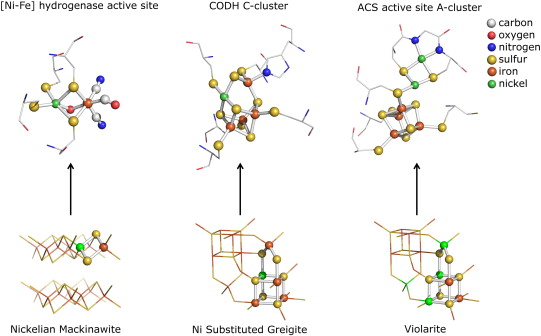
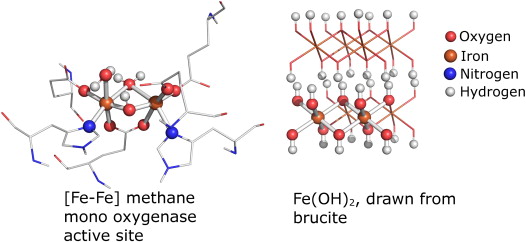
Even more amazing and interesting is that these metals alone, without the surrounding protein complex, have been shown to be able to catalyze key steps of the Krebs cycle. So we know that large parts of the chemistry is sound.
Another point is that some of the oldest metabolic protein enzymes we can resurrect using ancestral sequence reconstruction, show optimum activity and stability around 70 degrees celcius.
In this sense we have actual phylogenetic evidence of the primordial environment from which life emerged. In contrast to various RNA-world scenarios, which we don't have any phylogenetic evidence of.
What we have is evidence that life was once based on RNA instead of DNA, but this is not to be confused with evidence that RNA was the first stage of life.


Even more amazing and interesting is that these metals alone, without the surrounding protein complex, have been shown to be able to catalyze key steps of the Krebs cycle. So we know that large parts of the chemistry is sound.
Another point is that some of the oldest metabolic protein enzymes we can resurrect using ancestral sequence reconstruction, show optimum activity and stability around 70 degrees celcius.
In this sense we have actual phylogenetic evidence of the primordial environment from which life emerged. In contrast to various RNA-world scenarios, which we don't have any phylogenetic evidence of.
What we have is evidence that life was once based on RNA instead of DNA, but this is not to be confused with evidence that RNA was the first stage of life.
Ah, I thought this was all very familiar... For years now my favorite article on abiogenesis has been this one :
http://journalofcosmology.com/Abiogenesis107.html
It was the first where I wasn't "sure, could be" but "oh wow that makes sense". Its thermodynamics-based approach also seemed pretty sensible to me.
Turns out it's the same guy ! And his hypothesis seems to have expanded by leaps and bounds since that article; none of this talk about the archae-bacteria split and what we could infer from it was in there. This is very exciting and I look forward to reading all the articles you linked, Rumraket.
Like you I find these hypotheses much more compelling than RNA-first. It was especially evident in the next talk, where the speaker (Matthew Powner) ended by saying something like "and of course it would have been advantageous for those early replicators to be isolated from their environment so that their products weren't used by all the other replicators, so membranes would evolve, and then there would be competition for the most efficient enzymes..." Except that evolution (let alone early RNA molecules) have no foresight, so "it would be advantageous" is meaningless if you don't have a pathway where every single step is advantageous, and it often feels to me like gene-first explanations handwave that a bit. Nick Lane's explanations seem much more detail-oriented and compelling. He also seems to be taking the question from the standpoint of "what would happen in this environment, what can we infer about what ancient life could have been like, and how do the two match ?", as opposed to "how could the elements of modern life form ?" which is what a lot of Powner's talk sounded like to me.
I want to say that both are important, we need to know how metabolism, membranes AND RNA appeared, and that both approaches need each other - RNA formation needs good thermodynamic conditions, and good thermodynamic conditions lead to RNA via a specific set of reactions. On the other hand a "how did modern living components arise" approach seems to me like it could lead to a number of dead ends. First because it's hard to tell the necessary features of life from the incidental ones (so maybe you'll reject a reaction because it forms A and not enough of B and modern life has B, but the truth is that that reaction is what happened and it's something down the line that caused B to become more common than A), and second because the only elements that need an abiotic explanation is those that actually had an abiotic origin. So efforts to figure out the abiotic origin of elements that we later find out we formed in early evolution would be wasted (well, I'm sure it would be useful chemical knowledge in any case, so not really wasted, but no directly applicable to Earth abiogenesis).
But that's a layperson's impressions; it's likely that the people involved know all this, and either have good reason to put such concerns on the back burner, or they do take them completely into account and I've just been misreading things. I mean, I've read the metabolism-first arguments against RNA-first and they made sense to me, but I didn't read the responses.
http://journalofcosmology.com/Abiogenesis107.html
It was the first where I wasn't "sure, could be" but "oh wow that makes sense". Its thermodynamics-based approach also seemed pretty sensible to me.
Turns out it's the same guy ! And his hypothesis seems to have expanded by leaps and bounds since that article; none of this talk about the archae-bacteria split and what we could infer from it was in there. This is very exciting and I look forward to reading all the articles you linked, Rumraket.
Like you I find these hypotheses much more compelling than RNA-first. It was especially evident in the next talk, where the speaker (Matthew Powner) ended by saying something like "and of course it would have been advantageous for those early replicators to be isolated from their environment so that their products weren't used by all the other replicators, so membranes would evolve, and then there would be competition for the most efficient enzymes..." Except that evolution (let alone early RNA molecules) have no foresight, so "it would be advantageous" is meaningless if you don't have a pathway where every single step is advantageous, and it often feels to me like gene-first explanations handwave that a bit. Nick Lane's explanations seem much more detail-oriented and compelling. He also seems to be taking the question from the standpoint of "what would happen in this environment, what can we infer about what ancient life could have been like, and how do the two match ?", as opposed to "how could the elements of modern life form ?" which is what a lot of Powner's talk sounded like to me.
I want to say that both are important, we need to know how metabolism, membranes AND RNA appeared, and that both approaches need each other - RNA formation needs good thermodynamic conditions, and good thermodynamic conditions lead to RNA via a specific set of reactions. On the other hand a "how did modern living components arise" approach seems to me like it could lead to a number of dead ends. First because it's hard to tell the necessary features of life from the incidental ones (so maybe you'll reject a reaction because it forms A and not enough of B and modern life has B, but the truth is that that reaction is what happened and it's something down the line that caused B to become more common than A), and second because the only elements that need an abiotic explanation is those that actually had an abiotic origin. So efforts to figure out the abiotic origin of elements that we later find out we formed in early evolution would be wasted (well, I'm sure it would be useful chemical knowledge in any case, so not really wasted, but no directly applicable to Earth abiogenesis).
But that's a layperson's impressions; it's likely that the people involved know all this, and either have good reason to put such concerns on the back burner, or they do take them completely into account and I've just been misreading things. I mean, I've read the metabolism-first arguments against RNA-first and they made sense to me, but I didn't read the responses.
